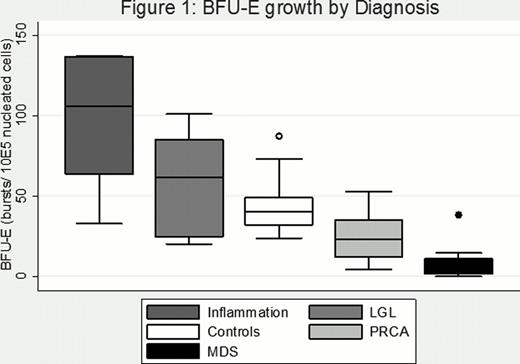Abstract
Abstract 3475
Cytopenias in the context of cellular marrows cause significant morbidity for patients and are challenging for clinicians to diagnose and treat. Often the differential diagnosis includes pure red cell aplasia (PRCA), large granular lymphocyte leukemia (LGL), marrow suppression associated with systemic inflammation, and clonal bone marrow failure disorders such as myelodysplastic syndrome (MDS) or paroxysmal nocturnal hemoglobinuria (PNH). Unfortunately, it can be difficult to differentiate between these possibilities, and correct treatment depends on accurate diagnosis.
The diagnostic algorithm for these patients includes multiple studies: cytogenetics, fluorescence in situ hybridization, T cell gene rearrangements, and flow cytometry. These multiple tests rarely provide a definitive diagnosis and do not consistently predict response to therapy. Functional tests of effective hematopoiesis are lacking. Colony growth assays quantifying BFU-E in bursts per 105 marrow mononuclear nuclear cells (MMNC) have been shown to predict response to immunosuppressive therapy (IST) for the bone marrow failure disorder of PRCA. (Charles et al. Blood 1996) However, these data were from an era before it was recognized that PRCA had several etiologies, one of which was LGL.
We hypothesize that colony growth assays might provide diagnostic and therapeutic information in the evaluation of patients with bone marrow failure disorders. As part of an IRB-approved study, we performed a retrospective analysis on patients presenting for evaluation of cytopenias in the context of cellular marrows from January 2007-June 2012. Inclusion criteria were a recorded BFU-E assay performed prior to therapy, established diagnosis for the cytopenias and at least 6 months of follow up after treatment initiated. Response was defined as transfusion independence and ANC >1000/μL. For comparison, BFU-E in healthy controls was used.
Thirty-six patients meeting the above criteria had BFU-E assessed over the study. All patients' marrows were cellular or hypercellular for age, with a median cellularity of 60% (range 20–100). The diagnoses included 13 patients with LGL (8 of which had red cell aplasia only); 9 patients with PRCA (non-LGL in etiology); 8 patients with MDS; and 6 patients with cytopenias from systemic inflammation. The median follow up was 10.5 months (range 1–42). There were 8 deaths. There were 25 normal controls for comparison of BFU-E growth. The median growth in the normal controls was 40.3 BFU-E/105 MMNC (range 23.7–87).
The eight patients with MDS had the lowest median growth of all categories at 5 BFU-E/105 MMNC (range 0–38). Four of these patients with MDS died from progression to acute leukemia in less than 9 months after initiation of therapy. The 4 patients still alive remain red cell transfusion dependent despite therapy with demethylating agents. Two have increased blasts on restaging marrows.
The 13 patients with LGL grew a median of 61.3 BFU-E/105 MMNC (range 24.7–101). Nine patients (69%) responded to first or second line IST with durable remissions of 9 months or greater. One of the nonresponders died at 31 months from infection after multiple relapses and treatments.
The 9 non-LGL PRCA patients grew a median of 23 BFU-E/105 MMNC (range 4.5–49). Only three patients (33%) of these patients responded to IST. The etiologies of the PRCA included 2 associated with thymoma, 2 with anti-erythropoietin antibodies (2 deaths at 1 and 11 months), 2 with ABO-incompatible transplants, and 3 idiopathic PRCA patients (1 death at 15 months).
The 6 patients with cytopenias from systemic inflammation had documented autoimmunity (4 with Evan's syndrome and 2 with systemic lupus erythematosus) and grew a median of 105.5 BFU-E/105 MMNC (range 33–137). All 6 (100%) patients responded to IST.
In conclusion, patients with cellular marrows and cytopenias can be distinguished by BFU-E growth as seen in Figure 1. MDS patients have very low to undetectable growth. LGL and PRCA associated with LGL have high BFU-E growth, similar to other autoimmune processes, whereas non-LGL PRCA has low BFU-E growth. BFU-E predicts for response to IST in PRCA, as it seems to predict for LGL. In this cohort, nonmalignant diseases are well distinguished from MDS by BFU-E growth. Prospective studies of colony growth assays as part of the diagnostic algorithm for bone marrow failure disorders appear warranted.
No relevant conflicts of interest to declare.


This feature is available to Subscribers Only
Sign In or Create an Account Close Modal